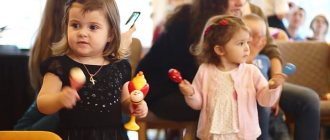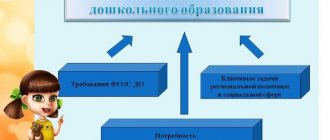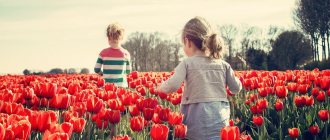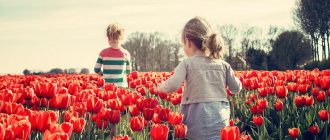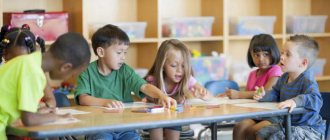Forms of working with books in kindergarten
Forms of working with books in kindergarten
Plan
| Introduction | 2 | |
| 1. | The importance of fiction in the development and upbringing of children. | 3 |
| 2. | Forms of working with books in kindergarten. | 5 |
| 3. | Literary evenings of leisure. | 8 |
| 4. | Organization and design of a corner for different age groups. | 10 |
| Practical part: | 15 | |
| 1. | Scenario of a literary evening in the preparatory group. | 15 |
| 2. | Photos of a book corner in each age group in the garden. Conclusions. | 19 |
| 3. | Sketch of a book corner. | 20 |
| Conclusion | 21 | |
| Bibliography | 22 | |
People stop thinking
when they stop reading.
(Diderot)
- Introduction
Preschool childhood as a period in human life plays an important role in shaping what not only each individual person will become, but also all of humanity and the world as a whole. The educational, ideological, moral, and cultural priorities laid down in preschool childhood determine the life path of generations and influence the development and state of the entire civilization.
It is necessary to pay as much attention as possible to the development of the child’s inner world. Communication with a book provides invaluable assistance in this. Through reading fiction, a child learns the past, present and future of the world, learns to analyze, and develops moral and cultural values.
Modern children spend more and more time playing computer games and watching TV. Sociological research in our country and abroad has revealed negative trends: interest in reading among younger preschoolers and adolescents is noticeably reduced; The share of reading in children's free time has been sharply reduced.
Today, in order to raise a reader in a child, an adult must himself show interest in a book, understand its role in a person’s life, know the books recommended for preschool children, be able to have an interesting conversation with kids and help in analyzing the work.
- The importance of fiction in the development and upbringing of children
Fiction serves as a powerful, effective means of mental, moral and aesthetic education of children; it has a huge impact on the development and enrichment of children's speech.
In poetic images, fiction reveals and explains to the child the life of society and nature, the world of human feelings and relationships. It makes emotions more intense, fosters imagination and gives preschoolers excellent examples of the Russian literary language. These samples vary in their impact; in stories, children learn the conciseness and precision of words, in poetry they capture the musicality, melodiousness, and imagery of Russian speech; folk tales reveal to them the accuracy and expressiveness of the Russian word, show how rich their native speech is in humor, lively and figurative expressions, and comparisons. Preschool children —
listeners, not readers, the work of art is conveyed to them by the teacher, so the mastery of expressive reading skills acquires special importance. The teacher faces an important task - each work needs to be conveyed to children as a work of art, to reveal its intention, to infect the listener with an emotional attitude towards what they read; feelings, actions, lyrical experiences of the characters1.
The ability to correctly perceive a literary work, to understand, along with the content, elements of artistic expression, does not come to the child by itself: it must be developed and educated from a very early age. In this regard, it is very important to develop in children the ability to actively listen to a work, to listen attentively to artistic speech. Thanks to these skills, the child will develop his own bright, imaginative, colorful, grammatically correct speech.
The importance of fiction in raising children is determined by its social, as well as educational role in the life of the entire people.
The art of words reflects reality through artistic images, shows the most typical, comprehending and generalizing real life facts. This helps the child learn about life and shapes his attitude towards the environment. Works of fiction, revealing the inner world of the heroes, make children worry and experience the joys and sorrows of the heroes as if they were their own.
The kindergarten introduces preschoolers to the best works for children and, on this basis, solves a whole complex of interrelated problems of moral, mental, and aesthetic education.
The process of development of aesthetic perception is very noticeable in preschool age. A child can understand that a work of art reflects the typical features of phenomena as early as 4-5 years old. Researchers note such a feature of a child’s artistic perception as activity and deep empathy for the heroes of the works. Older preschoolers acquire the ability to mentally act in imaginary circumstances, as if to take the place of the hero. For example, together with the heroes of a fairy tale, children experience a feeling of fear in tense dramatic moments, a feeling of relief, and satisfaction when justice triumphs.
A work of art attracts a child not only with its bright figurative form, but also with its semantic content. Older preschoolers, perceiving a work, can give a conscious, motivated assessment of the characters, using in their judgments the criteria of human behavior in our socialist society that they have developed under the influence of upbringing. Direct empathy for the characters, the ability to follow the development of the plot, comparison of the events described in the work with those that he had to observe in life, help the child relatively quickly and correctly understand realistic stories, fairy tales, and by the end of preschool age - shapeshifters, fables. The insufficient level of development of abstract thinking makes it difficult for children to perceive genres such as fables, proverbs, riddles, and necessitates the help of an adult.
Preschoolers are capable of mastering a poetic ear and can understand the basic differences between prose and poetry.
Children of senior preschool age, under the influence of the targeted guidance of educators, are able to see the unity of the content of a work and its artistic form, find figurative words and expressions in it, feel the rhythm and rhyme of the poem, even remember the figurative means used by other poets.
Thus, it is important to recognize the reading process as decisive in the education and development, ideological and moral formation of a person and a child.
- Forms of working with books in kindergarten.
Currently, in pedagogy, to define speech activity that has a pronounced aesthetic orientation, the term “artistic speech activity of children” has been adopted. In terms of its content, this is an activity related to the perception of literary works and their execution, including the development of initial forms of verbal creativity (inventing stories and fairy tales, riddles, rhymed lines), as well as imagery and expressiveness of speech.
It is clearly seen that this concept also includes the formation of coherent speech, vocabulary work, etc.
Ensuring that the child masters the content of the works and understands them correctly is an important task.
The teacher develops in children the ability to perceive a literary work.
Traditionally, in the methodology of speech development, it is customary to distinguish two forms of working with books in kindergarten: reading and telling fiction and memorizing poems and using literary works and works of oral folk art outside of class, in different types of activities2.
When introducing preschoolers to fiction, various methods are used to form a full-fledged perception of the work by children:
• expressive reading by the teacher;
• conversation about what you read;
• repeated reading;
• looking at illustrations;
• explanation of unfamiliar words.
A special place in children's reading is occupied by such a genre as a story for little ones. Reading the story, as noted by R.I. Zhukovskaya, gives the child the opportunity to follow the life and adventures of the same hero for a long time.
In early preschool age, children are taught a love and interest in books and illustrations, the ability to focus attention on the text, listen to it to the end, understand the content and respond emotionally to it. Children develop joint listening skills, the ability to answer questions, and a careful attitude towards books.
The teacher names the genre of fiction: “I’ll tell a fairy tale, read a poem.” After telling a fairy tale, the teacher helps the children remember interesting places, repeat the characteristics of the characters (“Peter the Cockerel, the golden comb,” “The turnip has grown big and big,” name repeated appeals (“Little goats, kids, open up, open up!”, “Terem-Teremok , who lives in the mansion?”) and actions (“They pull and pull, but they can’t pull it out.”) Helps you remember this material and learn to repeat it with different intonations.
In middle preschool age, the work of instilling in children the ability to perceive a literary work and the desire to respond emotionally to the events described deepens. Children's attention is drawn both to the content and to the form of the work that is easily distinguishable by ear (poetry, prose), as well as to some features of the literary language (comparisons, epithets). This promotes the development of a poetic ear and sensitivity to figurative speech. As in younger groups, the teacher names the genre of the work. It becomes possible to conduct a small analysis of the work, that is, a conversation about what has been read. Children are taught to answer questions about whether they liked the fairy tale (story), what it is about, what words it begins and what it ends with. A conversation develops the ability to think, express one’s attitude towards characters, correctly evaluate their actions, characterize moral qualities, and makes it possible to maintain interest in literary words, figurative expressions, and grammatical structures.
In older preschool age, a strong interest in books arises and a desire to listen to them read. The accumulated life and literary experience gives the child the opportunity to understand the idea of the work, the actions of the characters, and the motives of behavior. Children begin to consciously relate to the author's word, notice the features of language, figurative speech and reproduce it.
In working with children in this section of the program outside of class, two directions emerge: the first, when the teacher purposefully organizes preschoolers to perceive works, and the second, the independent use of works by children on their own initiative with the indirect participation of an adult.
Methods of introducing children to the book; educational and methodological guide for speech development on the topic
Topic: Methods of introducing children to books
Literature:
Alekseeva M.M., Yashina V.I. Methods of speech development and teaching the native language of preschoolers - M, 2004.
Ushakova O.S., Strunina E.M. Methods of speech development for preschool children. - M., 2008.
Introduction
Preschool childhood as a period in human life plays an important role in shaping what not only each individual person will become, but also all of humanity and the world as a whole. The educational, ideological, moral, and cultural priorities laid down in preschool childhood determine the life path of generations and influence the development and state of the entire civilization. It is necessary to pay as much attention as possible to the development of the child’s inner world. Communication with a book provides invaluable assistance in this. Through reading fiction, a child learns the past, present and future of the world, learns to analyze, and develops moral and cultural values. Modern children spend more and more time playing computer games and watching TV. Sociological research in our country and abroad has revealed negative trends: interest in reading among younger preschoolers and adolescents is noticeably reduced; The share of reading in children's free time has been sharply reduced. Today, in order to raise a reader in a child, an adult must himself show interest in a book, understand its role in a person’s life, know the books recommended for preschool children, be able to have an interesting conversation with kids and help in analyzing the work.
Children's books are considered as a means of mental, moral and aesthetic education. Children's poet I. Tokmakova calls children's literature the fundamental basis of education. According to V. A. Sukhomlinsky, “reading books is the path along which a skillful, intelligent, thinking teacher finds the way to a child’s heart.” Fiction shapes moral feelings and assessments, norms of moral behavior, and cultivates aesthetic perception.
Works of literature contribute to the development of speech and provide examples of the Russian literary language. E. A. Flerina noted that a literary work provides ready-made linguistic forms, verbal characteristics of the image, definitions with which the child operates. By means of artistic expression, even before school, before mastering grammatical rules, a small child practically masters the grammatical norms of the language in unity with its vocabulary.
N. S. Karpinskaya also believed that a fiction book provides excellent examples of literary language. In stories, children learn laconicism and precision of language; in poetry - musicality, melodiousness, rhythm of Russian speech; in fairy tales - accuracy, expressiveness.
From the book, the child learns many new words and figurative expressions, his speech is enriched with emotional and poetic vocabulary. Literature helps children express their attitude to what they have heard, using comparisons, metaphors, epithets and other means of figurative expression.
When familiarizing yourself with the book, the connection between speech and aesthetic development clearly appears; language is assimilated in its aesthetic function. Mastery of linguistic figurative and expressive means serves to develop the artistic perception of literary works.
The educational function of literature is carried out in a special way, inherent only to art - by the force of influence of the artistic image. In order to fully realize the educational potential of literature, it is necessary to know the psychological characteristics of the perception and understanding of this type of art by preschoolers.
FORMS OF WORKING WITH THE BOOK
Currently, in pedagogy, to define speech activity that has a pronounced aesthetic orientation, the term “artistic speech activity of children” has been adopted. In terms of its content, this is an activity related to the perception of literary works and their execution, including the development of initial forms of verbal creativity (inventing stories and fairy tales, riddles, rhymed lines), as well as imagery and expressiveness of speech.
It is clearly seen that this concept also includes the formation of coherent speech, vocabulary work, etc.
Ensuring that the child masters the content of the works and understands them correctly is an important task.
The teacher develops in children the ability to perceive a literary work.
The methodology for working with books in kindergarten has been studied and disclosed in monographs, methodological and teaching aids.
Let us briefly discuss the methods of familiarization with fiction.
The main methods are the following:
1. Reading by the teacher from a book or by heart. This is a literal rendering of the text. The reader, preserving the author’s language, conveys all the shades of the writer’s thoughts and influences the mind and feelings of the listeners. A significant part of literary works is read from a book.
2. The teacher's story. This is a relatively free transmission of text (words may be rearranged, replaced, or interpreted). Storytelling provides great opportunities to attract children's attention.
3. Staging. This method can be considered as a means of secondary familiarization with a work of art.
4. Learning by heart/The choice of method of transmitting a work (reading or telling) depends on the genre of the work and the age of the listeners.
Traditionally, in the methodology of speech development, it is customary to distinguish two forms of working with books in kindergarten: reading and telling fiction and memorizing poems in class, and using literary works and works of oral folk art outside of class, in different types of activities.
Let's look at the methods of artistic reading and storytelling in the classroom.
M. M. Konina identifies several types of classes:
1. Reading or telling one work.
2. Reading several works united by a single theme (reading poems and stories about spring, about the life of animals) or unity of images (two fairy tales about a fox). You can combine works of the same genre (two stories with moral content) or several genres (a riddle, a story, a poem). These classes combine new and already familiar material.
3. Combining works belonging to different types of art:
· reading a literary work and looking at reproductions of a painting by a famous artist;
· reading (preferably a poetic work) in combination with music.
In such classes, the power of influence of works on the child’s emotions is taken into account. There should be a certain logic in the selection of material - increased emotional intensity by the end of the lesson. At the same time, the characteristics of children’s behavior, culture of perception, and emotional responsiveness are taken into account.
4. Reading and storytelling using visual material:
· reading and storytelling with toys (re-telling the tale “The Three Bears” is accompanied by showing toys and actions with them);
· tabletop theater (cardboard or plywood, for example, based on the fairy tale “Turnip”);
· puppet and shadow theater, flannelgraph;
· filmstrips, transparencies, films, television shows.
5. Reading as part of a speech development lesson:
· it can be logically connected with the content of the lesson (during a conversation about school, reading poetry, asking riddles);
· reading can be an independent part of the lesson (re-reading poetry or a story as a reinforcement of the material).
PREPARATION OF TEACHERS AND CHILDREN
In the teaching methodology, issues such as preparation for the lesson and methodological requirements for it, conversation about what has been read, repeated reading, and the use of illustrations should be highlighted.
Preparation for the lesson includes the following points:
· a reasonable choice of work in accordance with developed criteria (artistic level and educational value), taking into account the age of the children, current educational work with children and the time of year, as well as the choice of methods for working with the book; · determination of program content - literary and educational tasks;
· preparing the teacher for reading the work. It is necessary to read the work so that children understand the main content, idea and emotionally experience what they listen to (feel it).
For this purpose, it is necessary to conduct a literary analysis of a literary text: to understand the main intention of the author, the character of the characters, their relationships, and the motives of their actions.
Next comes work on the expressiveness of the transmission: mastering the means of emotional and figurative expressiveness (basic tone, intonation); placement of logical stresses, pauses; developing correct pronunciation and good diction.
The preliminary work also includes preparing the children. First of all, preparation for the perception of a literary text, for understanding its content and form. Even K. D. Ushinsky considered it necessary “to first bring the child to understand the work that is supposed to be read, and then read it, without weakening the impression with unnecessary interpretations.” To this end, you can intensify the personal experience of children, enrich their ideas by organizing observations, excursions, viewing paintings and illustrations.
Explanation of unfamiliar words is a mandatory technique that ensures a full perception of the work. It is necessary to explain the meanings of those words, without understanding which the main meaning of the text, the nature of the images, and the actions of the characters become unclear. The explanation options are different: substituting another word while reading prose, selecting synonyms (bast hut - wooden, upper room - room); the use of words or phrases by the teacher before reading, while introducing the children to the picture (“milk flows down the mark, and from the mark down the hoof” - when looking at the goat in the picture); asking children about the meaning of a word, etc.
At the same time, when analyzing the text, we must remember that not all words require interpretation. Thus, when reading the fairy tales of A. S. Pushkin, there is no need to explain the concepts of “pillar noblewoman”, “sable soul warmer”, “printed gingerbread”, since they do not interfere with the understanding of the main content. It is a mistake to ask children what they do not understand in the text, but when asked about the meaning of a word, it is necessary to give an answer in a form understandable to the child.
The methodology for conducting artistic reading and storytelling classes and its structure depend on the type of lesson, the content of the literary material and the age of the children. The structure of a typical lesson can be divided into three parts. In the first part, an introduction to the work takes place; the main goal is to provide children with a correct and vivid perception through artistic expression. In the second part, a conversation is held about what has been read in order to clarify the content, literary and artistic form, and means of artistic expression. In the third part, repeated reading of the text is organized in order to consolidate the emotional impression and deepen the perception. Conducting a lesson requires creating a calm environment, clear organization of children, and an appropriate emotional atmosphere. Reading may be preceded by a short introductory conversation, preparing children for perception, connecting their experience, current events with the theme of the work. Such a conversation may include a short story about the writer, a reminder of his other books that are already familiar to children. If children have been prepared by previous work to perceive a book, you can arouse their interest with the help of a riddle, a poem, or a picture. Next, you need to name the work, its genre (story, fairy tale, poem), and the name of the author. Expressive reading, the interest of the teacher himself, his emotional contact with children increase the degree of impact of the literary word. While reading, children should not be distracted from perceiving the text with questions or disciplinary remarks; raising or lowering the voice or pausing is enough. After finishing reading, while the children are impressed by what they heard, a short pause is necessary. You can ask whether you liked the fairy tale and emphasize: “A good goldfish, how it helped the old man!”, or “What a Zhikharka! Small and remote!” If understanding a work makes it difficult for children, a conversation is possible immediately after reading it. Questions can be conditionally classified as follows: • allowing you to find out the emotional attitude to events and characters (“Who did you like best? Why? Do you like the hero or not?”); • aimed at identifying the main meaning of the work, its problem. For example, after reading a fairy tale by A.M. Gorky's "Sparrow" you can ask the following question: "Who is to blame for the fact that mother was left without a tail?"; • aimed at clarifying the motive of actions ("Why didn't Masha allow the bear to rest?" - the fairy tale "Masha and the Bear"); converting attention to linguistic means of expression; aimed at reproducing the content; • leading to conclusions (“Why did the writer call his story that? Why did the writer tell us this story?”) When reading popular science books, for example about work, about nature, conversation accompanies reading and is even included in the reading process. The content of books of an educational nature indicates the need for conversation to successfully solve the main educational task (based on the books by S. Baruzdin “Who Built This House?”, S. Marshak “Where the Table Came From,” V. Mayakovsky “The Horse” -fire”, etc.). At the end of the lesson, you can re-read the work (if it is short) and look at the illustrations, which deepen your understanding of the text, clarify it, and more fully reveal artistic images. The method of using illustrations depends on the content and form of the book, and on the age of the children. The basic principle is that showing illustrations should not disrupt the holistic perception of the text. A picture book can be given a few days before reading to stimulate interest in the text, or the pictures are examined in an organized manner after reading. If the book is divided into small chapters, illustrations are considered after each part. And only when reading a book of an educational nature, a picture is used at any time to visually explain the text. This will not break the unity of impression. (The method of familiarization with book illustrations is discussed in more detail in the works of T.A. Repina, V.A. Ezikeeva, I. Kotova.) One of the techniques that deepens the understanding of the content and means of expression is repeated reading. Small works are repeated immediately after the initial reading, large ones require some time to comprehend. Further, it is possible to read only individual, most significant parts. It is advisable to re-read all this material after some period of time (2-3 weeks). Reading poems, nursery rhymes, and short stories is repeated more often. Children love to listen to familiar stories and fairy tales over and over again. When repeating, it is necessary to accurately reproduce the original text. Familiar works can be included in other speech development activities, literature and entertainment. Thus, when introducing preschoolers to fiction, various methods are used to form a full perception of the work by children: • expressive reading by the teacher; • conversation about what you read; • repeated reading; • looking at illustrations; • explanation of unfamiliar words. A special place in children's reading is occupied by such a genre as a story for little ones. Reading the story, as noted by R.I. Zhukovskaya, gives the child the opportunity to follow the life and adventures of the same hero for a long time. Reading such a book becomes especially exciting for children if the most interesting chapters are read repeatedly. It is important to correctly divide the work into parts. Each part must be complete. You can't stop at the most interesting place. Reading “long” books teaches children to follow the actions of the characters for a long time, evaluate their actions, establish their attitude towards them, teaches them to retain what they read in their memory and connect parts of the text. Reading books with moral content is of great importance. Through artistic images, they develop courage, a sense of pride and admiration for the heroism of people, empathy, responsiveness, and a caring attitude towards loved ones. Reading these books is necessarily accompanied by conversation. Children learn to evaluate the actions of characters and their motives. The teacher helps children understand their relationship to the characters and achieves an understanding of the main goal. When the questions are asked correctly, the child has a desire to imitate the moral actions of the heroes. The conversation should be about the actions of the characters, and not about the behavior of the children of the group. The work itself, through the power of artistic image, will have a greater impact than any moralizing. For reading, you can combine two or more works thematically. One of them may be familiar to children, the other new. So, on the topic of “friendship” it is good to combine the stories of L.N. Tolstoy “Two Comrades” and the story by V.A. Oseyeva “Blue leaves”. On politeness and respect for others, we can recommend books by V.A. Oseyeva “The Magic Word”, “Just an Old Lady”, “Cookies”; S. V. Mikhalkova “One rhyme”; Russian folk tale “Morozko”, adapted by A. Tolstoy; L. Voronkova “Girlfriends Go to School” and others. A special place in children's reading is occupied by such a genre as a story for little ones. Reading the story, as noted by R.I. Zhukovskaya, gives the child the opportunity to follow the life and adventures of the same hero for a long time.
Methods of familiarization with fiction books at different age stages.
In early preschool age, children are taught a love and interest in books and illustrations, the ability to focus attention on the text, listen to it to the end, understand the content and respond emotionally to it. Children develop joint listening skills, the ability to answer questions, and a careful attitude towards books. Starting from the younger group, children are introduced to the difference between genres. The teacher himself names the genre of fiction: “I’ll tell a fairy tale, read a poem.” After telling a fairy tale, the teacher helps the children remember interesting places, repeat the characteristics of the characters (“Peter the Cockerel, the golden comb,” “The turnip has grown big and big,” name repeated appeals (“Little goats, kids, open up, open up!”, “Terem-Teremok , who lives in the mansion?") and actions (“They pull and pull, but they can’t pull it out.”) Helps to remember this material and learn to repeat it with different intonations. Children are able to understand and remember a fairy tale, repeat a song, but their speech is not expressive enough . The reasons may be poor diction, inability to pronounce sounds correctly. Therefore, it is necessary to teach children to pronounce sounds clearly and distinctly, repeat words and phrases; create conditions for new words to enter the active vocabulary. In middle preschool age, the work of education in children deepens ability to perceive a literary work, the desire to respond emotionally to the events described.In classes, children’s attention is drawn to both the content and the easily audible (poetry, prose) form of the work, as well as to some features of the literary language (comparisons, epithets). This promotes the development of a poetic ear and sensitivity to figurative speech. As in younger groups, the teacher names the genre of the work. It becomes possible to conduct a small analysis of the work, that is, a conversation about what has been read. Children are taught to answer questions about whether they liked the fairy tale (story), what it is about, what words it begins and what it ends with. A conversation develops the ability to think, express one’s attitude towards characters, correctly evaluate their actions, characterize moral qualities, and makes it possible to maintain interest in literary words, figurative expressions, and grammatical structures. In older preschool age, a strong interest in books arises and a desire to listen to them read. The accumulated life and literary experience gives the child the opportunity to understand the idea of the work, the actions of the characters, and the motives of behavior. Children begin to consciously relate to the author's word, notice the features of language, figurative speech and reproduce it. Systematic, targeted work is needed to familiarize children with the genre of prose and poetry, with the content of fairy tales and stories, with their compositional and linguistic features. In this case, verbal methodological techniques are used in combination with visual ones: conversations after familiarization with the work, helping to determine the genre, main content, means of artistic expression; reading fragments from the work at the request of children (selective reading); conversations about previously read favorite books by children; getting to know the writer: showing a portrait, talking about his work, looking at books and their illustrations; viewing filmstrips, films, slides on literary works (possible only after familiarization with the text of the book); listening to recordings of literary works performed by masters of artistic expression. Children express their attitude to fairy tales, short stories, fables and poems in drawings, so the plots of literary works can be offered as themes for drawing. It is recommended to use creative tasks for the selection of comparisons, epithets, synonyms, antonyms, for the selection of rhymes for words and phrases from a work of art, for the continuation of the author's story, for inventing the plot of a fairy tale, for composing a creative story based on a nursery rhyme, riddle, or song. Doing creative activities helps children develop a deeper understanding of the different artistic mediums used in the book. In the classroom, you can use dramatizations: dramatization games, theatrical performances by children, puppet and shadow theaters, toy theaters, tabletop cardboard or plywood theaters, flannelgraph, etc. Children can be both spectators and performers.
Conclusion
Thus, during their stay in kindergarten, future schoolchildren will listen to and retell many fairy tales, stories, and poems. The future little reader imitates adults in everything. If he sees that the teacher washes his hands before opening the book, never bends it, carefully turns the pages, and when he encounters crumpled or painted ones, he expresses displeasure, the child himself gradually becomes a defender of the book.
Even if the baby doesn’t know how to read yet, he is taught to look at books not only with an adult, but also on his own. Children should learn at a young age: books are our friends. Patiently and persistently, the teacher teaches how to get a book from the shelf, how to examine it correctly and how to put it back in its place. Gradually, children learn the following words: binding, cover, page, and a little later - spine
